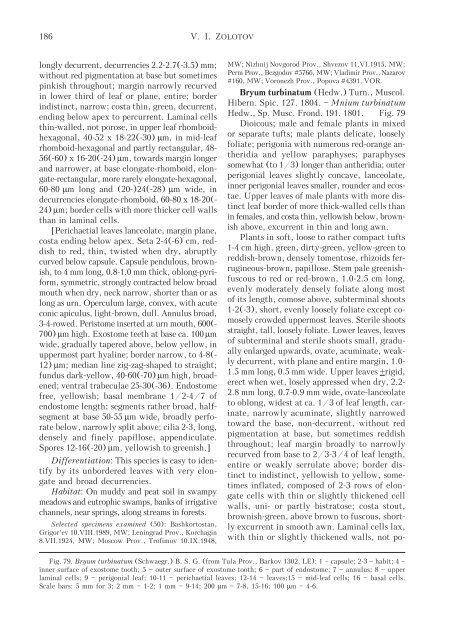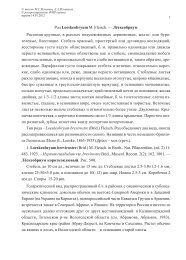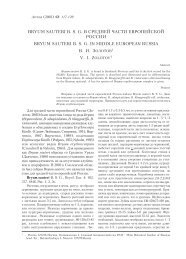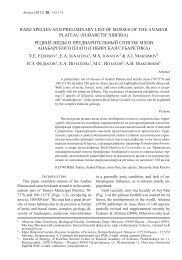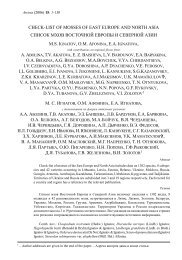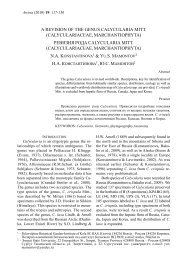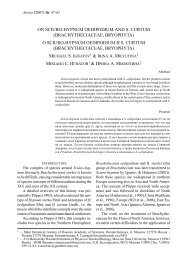THE GENUS BRYUM (BRYACEAE, MUSCI) IN MIDDLE ... - Arctoa
THE GENUS BRYUM (BRYACEAE, MUSCI) IN MIDDLE ... - Arctoa
THE GENUS BRYUM (BRYACEAE, MUSCI) IN MIDDLE ... - Arctoa
You also want an ePaper? Increase the reach of your titles
YUMPU automatically turns print PDFs into web optimized ePapers that Google loves.
186<br />
longly decurrent, decurrencies 2.2-2.7(-3.5) mm;<br />
without red pigmentation at base but sometimes<br />
pinkish throughout; margin narrowly recurved<br />
in lower third of leaf or plane, entire; border<br />
indistinct, narrow; costa thin, green, decurrent,<br />
ending below apex to percurrent. Laminal cells<br />
thin-walled, not porose, in upper leaf rhomboidhexagonal,<br />
40-52 x 18-22(-30) μm, in mid-leaf<br />
rhomboid-hexagonal and partly rectangular, 48-<br />
56(-60) x 16-20(-24) μm, towards margin longer<br />
and narrower, at base elongate-rhomboid, elongate-rectangular,<br />
more rarely elongate-hexagonal,<br />
60-80 μm long and (20-)24(-28) μm wide, in<br />
decurrencies elongate-rhomboid, 60-80 x 18-20(-<br />
24) μm; border cells with more thicker cell walls<br />
than in laminal cells.<br />
[Perichaetial leaves lanceolate, margin plane,<br />
costa ending below apex. Seta 2-4(-6) cm, reddish<br />
to red, thin, twisted when dry, abruptly<br />
curved below capsule. Capsule pendulous, brownish,<br />
to 4 mm long, 0.8-1.0 mm thick, oblong-pyriform,<br />
symmetric, strongly contracted below broad<br />
mouth when dry, neck narrow, shorter than or as<br />
long as urn. Operculum large, convex, with acute<br />
conic apiculus, light-brown, dull. Annulus broad,<br />
3-4-rowed. Peristome inserted at urn mouth, 600(-<br />
700) μm high. Exostome teeth at base ca. 100 μm<br />
wide, gradually tapered above, below yellow, in<br />
uppermost part hyaline; border narrow, to 4-8(-<br />
12) μm; median line zig-zag-shaped to straight;<br />
fundus dark-yellow, 40-60(-70) μm high, broadened;<br />
ventral trabeculae 25-30(-36). Endostome<br />
free, yellowish; basal membrane 1/2-4/7 of<br />
endostome length; segments rather broad, halfsegment<br />
at base 50-55 μm wide, broadly perforate<br />
below, narrowly split above; cilia 2-3, long,<br />
densely and finely papillose, appendiculate.<br />
Spores 12-16(-20) μm, yellowish to greenish.]<br />
Differentiation: This species is easy to identify<br />
by its unbordered leaves with very elongate<br />
and broad decurrencies.<br />
Habitat: On muddy and peat soil in swampy<br />
meadows and eutrophic swamps, banks of irrigative<br />
channels, near springs, along streams in forests.<br />
Selected specimens examined (50): Bashkortostan,<br />
Grigor’ev 10.VIII.1989, MW; Leningrad Prov., Korchagin<br />
8.VII.1924, MW; Moscow Prov., Trofimov 10.IX.1948,<br />
V. I. ZOLOTOV<br />
MW; Nizhnij Novgorod Prov., Shvezov 11.VI.1915, MW;<br />
Perm Prov., Bezgodov #576á, MW; Vladimir Prov., Nazarov<br />
#160, MW; Voronezh Prov., Popova #4391, VOR.<br />
Bryum turbinatum (Hedw.) Turn., Muscol.<br />
Hibern. Spic. 127. 1804. – Mnium turbinatum<br />
Hedw., Sp. Musc. Frond. 191. 1801. Fig. 79<br />
Dioicous; male and female plants in mixed<br />
or separate tufts; male plants delicate, loosely<br />
foliate; perigonia with numerous red-orange antheridia<br />
and yellow paraphyses; paraphyses<br />
somewhat (to 1/3) longer than antheridia; outer<br />
perigonial leaves slightly concave, lanceolate,<br />
inner perigonial leaves smaller, rounder and ecostae.<br />
Upper leaves of male plants with more distinct<br />
leaf border of more thick-walled cells than<br />
in females, and costa thin, yellowish below, brownish<br />
above, excurrent in thin and long awn.<br />
Plants in soft, loose to rather compact tufts<br />
1-4 cm high, green, dirty-green, yellow-green to<br />
reddish-brown, densely tomentose, rhizoids ferrugineous-brown,<br />
papillose. Stem pale greenishfuscous<br />
to red or red-brown, 1.0-2.5 cm long,<br />
evenly moderately densely foliate along most<br />
of its length, comose above, subterminal shoots<br />
1-2(-3), short, evenly loosely foliate except comosely<br />
crowded uppermost leaves. Sterile shoots<br />
straight, tall, loosely foliate. Lower leaves, leaves<br />
of subterminal and sterile shoots small, gradually<br />
enlarged upwards, ovate, acuminate, weakly<br />
decurrent, with plane and entire margin, 1.0-<br />
1.5 mm long, 0.5 mm wide. Upper leaves +rigid,<br />
erect when wet, losely appressed when dry, 2.2-<br />
2.8 mm long, 0.7-0.9 mm wide, ovate-lanceolate<br />
to oblong, widest at ca. 1/3 of leaf length, carinate,<br />
narrowly acuminate, slightly narrowed<br />
toward the base, non-decurrent, without red<br />
pigmentation at base, but sometimes reddish<br />
throughout; leaf margin broadly to narrowly<br />
recurved from base to 2/3-3/4 of leaf length,<br />
entire or weakly serrulate above; border distinct<br />
to indistinct, yellowish to yellow, sometimes<br />
inflated, composed of 2-3 rows of elongate<br />
cells with thin or slightly thickened cell<br />
walls, uni- or partly bistratose; costa stout,<br />
brownish-green, above brown to fuscous, shortly<br />
excurrent in smooth awn. Laminal cells lax,<br />
with thin or slightly thickened walls, not po-<br />
Fig. 79. Bryum turbinatum (Schwaegr.) B. S. G. (from Tula Prov., Barkov 1302, LE): 1 – capsule; 2-3 – habit; 4 –<br />
inner surface of exostome tooth; 5 – outer surface of exostome tooth; 6 – part of endostome; 7 – annulus; 8 – upper<br />
laminal cells; 9 – perigonial leaf; 10-11 – perichaetial leaves; 12-14 – leaves;15 – mid-leaf cells; 16 – basal cells.<br />
Scale bars: 5 mm for 3; 2 mm – 1-2; 1 mm – 9-14; 200 μm – 7-8, 15-16; 100 μm – 4-6.


